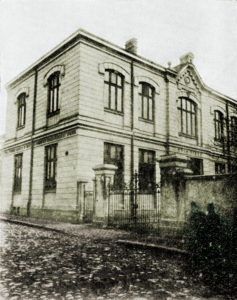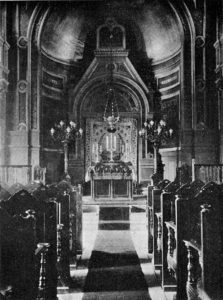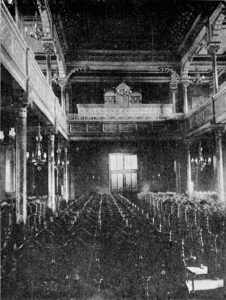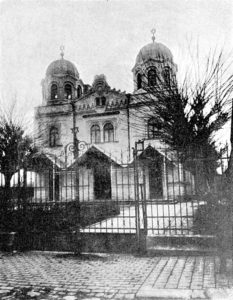
Lazar Ascher, president of Bucharest’s Sephardic Kehilla, president of the Bucharest Sephardic Jewish Primary Schools Society, early 1900s.
Today’s “guest blogger” from the past is Lazar (Lazaro) Ascher, a board member of several Sephardic organizations in Bucharest, Romania, in the 19th and early 20th centuries. He was a brother of Moscu Ascher, the noted Jewish philanthropist and educational reformer.
In this letter, Lazar writes about Bucharest’s “Spanish Jews” (Sephardim). The synagogue he describes is the Great Spanish Temple, also called Kahal Kadosh Gadol and Kahal Grande. That beautiful building, seen in photos below, stood at 10 Nedru Voda Street from the 1810s until the Iron Guard pogrom of 1941, just months before the Holocaust began.
You can find the complete 1904 letter and other correspondence from Sephardim of that era in Ángel Pulido’s book Sephardic Jews and the Spanish Language.
EXCERPTS FROM A LETTER TO
SENATOR ÁNGEL PULIDO, MADRID
[Translation from Spanish
© 2016 by Steven Capsuto]
Bucharest, February 16, 1904.
I was… overjoyed to learn that you are writing articles about the Spanish Jews, and that you want me to send photographs of our Synagogue and School. I’m glad to say I acted quickly and had photos taken of two parts of the Synagogue’s Moorish-style interior and of the facade. I also had pictures taken of our Jewish Community Schools for boys and for girls. I hope these are of use…
The Synagogue, built in 1817 and rebuilt in 1852, has 350 seats for men downstairs and 150 for women up in the gallery. The left and right galleries have entrances separate from the lower-level entry.
Our Community has had its Boys’ School since 1730. The school did not originally have its own space, but in 1817 four rooms were built for it on the grounds of the synagogue, and in 1894 the current building was erected. It is overseen by a five-man Committee. The Institute bears the name “School for Sons of the Spanish Israelite Community”…

The Spanish-Jewish Primary School for Boys. It was previously known simply as the Talmud Torah, which is what the sign over the door says. By 1904, this and the girls’ school were prestigious private elementary schools whose students attended free of charge, thanks to funding from the Halfon family foundation.
Our Community has had its Girls’ School since Continue reading




